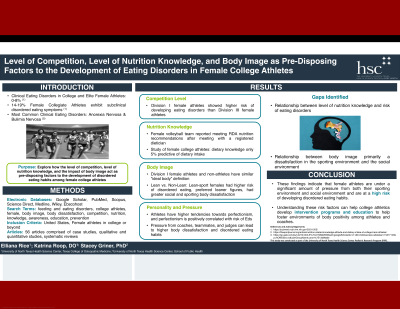Back

Clinical: General Topics
Predisposing Factors to the Development of Eating Disorders in Female Collegiate Athletes
Friday, March 31, 2023
12:00 PM East Coast USA Time


Elliana Rice, OMS
Texas College of Osteopathic Medicine
Fort Worth, Texas, United States
Presenting Author(s)
Background and Hypothesis: Eating disorders are serious psychiatric conditions. The prevalence of clinical eating disorders in college and elite female athletes is as high as 8%, while 14-19% of female collegiate athletes have subclinical disordered eating patterns. The purpose of this study was to explore how the level of competition, the level of nutrition knowledge, and the impact of body image act as predisposing factors to the development of disordered eating habits among female college athletes.
Methods: A literature review process was conducted by searching electronic databases including PubMed, Scopus, Medline, and ScienceDirect. Keywords included disordered eating, feeding, and eating disorders, college athletes, female, body image, body dissatisfaction, competition, nutrition, knowledge, education, and prevention. This retrospective search was limited to articles: (i) in English, (ii) after 1997, (iii) included as participants, female athletes in college or beyond (professional), (iv) included nutrition, body image, or competition level in the title or abstract.
Results: Twenty-nine articles met the inclusion criteria and includes case studies (n=3), qualitative studies (n=7), quantitative studies (n=17), and systematic reviews (n=2). For competition level, Division I and elite athletes were at an increased risk of developing disordered eating compared to non-competitive athletes. With nutrition, female college athletes have inadequate diets to meet their energy needs, often due to a lack of nutritional knowledge. However, this relationship may be complex, as higher level of nutritional knowledge did not necessarily predict dietary intake. Regarding body image, athletes may have body dissatisfaction due to social appearance or sporting performance. Athletes and non-athletes had similar “ideal body” definitions and used media as sources for beauty information, yet there is conflicting evidence if female athlete body dissatisfaction stems more from dissatisfaction in their sporting performance body. This is often seen in “lean” sports such as swimming, cross country, and volleyball.
Two additional factors came to light during the review, perfectionism, and external pressure. Athletes have higher tendencies toward perfectionism, and perfectionism is positively correlated with the risk of developing disordered eating. Athletes also experience pressure about appearance from coaches, teammates, and judges, which influences development of body dissatisfaction and eating disorders in female athletes.
Conclusion: These findings indicate that female athletes are under pressure from their sporting and social environments and are at a high risk of developing disordered eating habits. Further research is needed, including research to determine the exact relationship between the level of nutritional knowledge and risk of developing disordered eating habits. This review has raised the questions of whether the issue of body image is primarily a dissatisfaction in the social or sporting environment, or a combination of both. These results can assist with identification of risk factors related to eating disorders and be used to target early identification and treatment to reduce the negative health outcomes of eating disorders. Osteopathic medicine emphasizes treatment of the entire person. This case seeks to get to the root of eating disorders to treat both body and mind and prevent the development of eating disorders.
Acknowledgement of Research Study Sponsors and IRB: This was a review of existing literature and did not include human subjects.
Methods: A literature review process was conducted by searching electronic databases including PubMed, Scopus, Medline, and ScienceDirect. Keywords included disordered eating, feeding, and eating disorders, college athletes, female, body image, body dissatisfaction, competition, nutrition, knowledge, education, and prevention. This retrospective search was limited to articles: (i) in English, (ii) after 1997, (iii) included as participants, female athletes in college or beyond (professional), (iv) included nutrition, body image, or competition level in the title or abstract.
Results: Twenty-nine articles met the inclusion criteria and includes case studies (n=3), qualitative studies (n=7), quantitative studies (n=17), and systematic reviews (n=2). For competition level, Division I and elite athletes were at an increased risk of developing disordered eating compared to non-competitive athletes. With nutrition, female college athletes have inadequate diets to meet their energy needs, often due to a lack of nutritional knowledge. However, this relationship may be complex, as higher level of nutritional knowledge did not necessarily predict dietary intake. Regarding body image, athletes may have body dissatisfaction due to social appearance or sporting performance. Athletes and non-athletes had similar “ideal body” definitions and used media as sources for beauty information, yet there is conflicting evidence if female athlete body dissatisfaction stems more from dissatisfaction in their sporting performance body. This is often seen in “lean” sports such as swimming, cross country, and volleyball.
Two additional factors came to light during the review, perfectionism, and external pressure. Athletes have higher tendencies toward perfectionism, and perfectionism is positively correlated with the risk of developing disordered eating. Athletes also experience pressure about appearance from coaches, teammates, and judges, which influences development of body dissatisfaction and eating disorders in female athletes.
Conclusion: These findings indicate that female athletes are under pressure from their sporting and social environments and are at a high risk of developing disordered eating habits. Further research is needed, including research to determine the exact relationship between the level of nutritional knowledge and risk of developing disordered eating habits. This review has raised the questions of whether the issue of body image is primarily a dissatisfaction in the social or sporting environment, or a combination of both. These results can assist with identification of risk factors related to eating disorders and be used to target early identification and treatment to reduce the negative health outcomes of eating disorders. Osteopathic medicine emphasizes treatment of the entire person. This case seeks to get to the root of eating disorders to treat both body and mind and prevent the development of eating disorders.
Acknowledgement of Research Study Sponsors and IRB: This was a review of existing literature and did not include human subjects.
